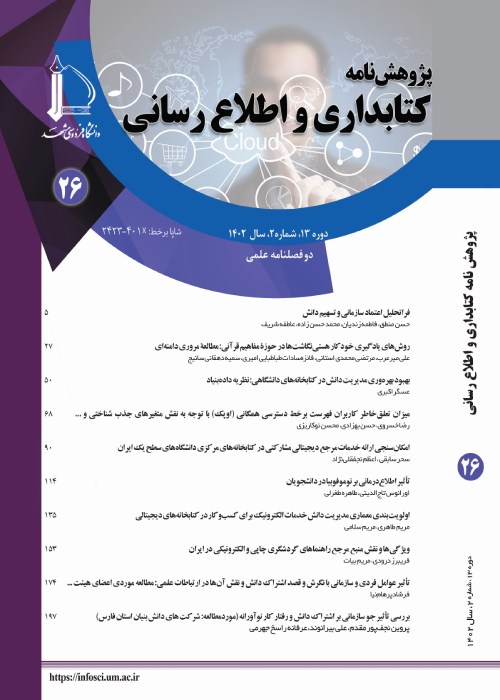Science Production Mapping in Iran, based on the Articles Indexed in Sciencefor Scientific Information (SCI-E)
Author(s):
Abstract:
INTRODUCTIONThe purpose of this article is to draw the science map through updated scientometric methods to visualize the published scientific information. This study tries to draw the science map in Iran in all subject categories.
FINDINGS:The findings illustrate that subject categories behave differently in self-citations and other's citations. The subject categories here may be classified in three divisions. Stable self-citation behavior was confirmed in 16 subject categories. Five other subject categories did not enjoy stability of behavior in self-citation, and this behavior was not observed in multiple-fields subject categories. Four or five subject categories were detected in citation environment of every subject category 80 percent of the citation environment of which was dedicated. These subject categories were identified and introduced as dominant subject categories for citing subject categories. On the basis of the drawn maps for 22 subject categories, those with most two-way citation interactions were identified and visualized.
The development policy of science has been based on information from publications, the number of faculty members, the number of universities and educational institutions, and so forth. Considering the characteristics of the structure of science and its behavior such as self and other-citation is necessary. This new component will support collaborations between the dominant and adjacent subject categories of citations for the text in any subject area and will increase the effectiveness of the targeted investments.
Methodology
As far as the methodology is concerned, this is an applied research using both co-citation analysis and survey. The population of the research consists of 11733 records of article being written by Iranian authors and indexed in Institute for Scientific Information (ISI) during 2001-2005. They were sampled down to 2826 records via stratified as well as systematic random sampling methods along with their references list including 59424 records which were systemized by means of Microsoft Excel and Access. The collected data were later analyzed by Chi-square, Pearson, Pareto Principle, and Cross Tab ranking process. Meanwhile, Visio software was employed to draw the map.FINDINGS:The findings illustrate that subject categories behave differently in self-citations and other's citations. The subject categories here may be classified in three divisions. Stable self-citation behavior was confirmed in 16 subject categories. Five other subject categories did not enjoy stability of behavior in self-citation, and this behavior was not observed in multiple-fields subject categories. Four or five subject categories were detected in citation environment of every subject category 80 percent of the citation environment of which was dedicated. These subject categories were identified and introduced as dominant subject categories for citing subject categories. On the basis of the drawn maps for 22 subject categories, those with most two-way citation interactions were identified and visualized.
Conclusions
In the 16 subject categories, the subject self-citation was certainly confirmed over five years. Therefore, scientific growth and fertility in this group through direct investment as the first priority for the same subject category is acceptable. Considering the dominant subject categories (four to five subject categories) accounting for 80 percent of the citations, the second priority is the investment on these subjects. A specialist in each of the specialized disciplines associated with these 16 subject categories will be able to research due to having access to scientific resources of the same subject along with 4 or 5 other subject categories.The development policy of science has been based on information from publications, the number of faculty members, the number of universities and educational institutions, and so forth. Considering the characteristics of the structure of science and its behavior such as self and other-citation is necessary. This new component will support collaborations between the dominant and adjacent subject categories of citations for the text in any subject area and will increase the effectiveness of the targeted investments.
Keywords:
Language:
Persian
Published:
Library and Information Science Research, Volume:7 Issue: 1, 2017
Pages:
5 to 26
magiran.com/p1743853
دانلود و مطالعه متن این مقاله با یکی از روشهای زیر امکان پذیر است:
اشتراک شخصی
با عضویت و پرداخت آنلاین حق اشتراک یکساله به مبلغ 1,390,000ريال میتوانید 70 عنوان مطلب دانلود کنید!
اشتراک سازمانی
به کتابخانه دانشگاه یا محل کار خود پیشنهاد کنید تا اشتراک سازمانی این پایگاه را برای دسترسی نامحدود همه کاربران به متن مطالب تهیه نمایند!
توجه!
- حق عضویت دریافتی صرف حمایت از نشریات عضو و نگهداری، تکمیل و توسعه مگیران میشود.
- پرداخت حق اشتراک و دانلود مقالات اجازه بازنشر آن در سایر رسانههای چاپی و دیجیتال را به کاربر نمیدهد.
In order to view content subscription is required
Personal subscription
Subscribe magiran.com for 70 € euros via PayPal and download 70 articles during a year.
Organization subscription
Please contact us to subscribe your university or library for unlimited access!


